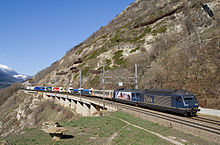
The Société nationale des chemins de fer français is France's national state-owned railway company. Founded in 1938, it operates the country's national rail traffic along with Monaco, including the TGV, on France's high-speed rail network. Its functions include operation of railway services for passengers and freight, as well as maintenance and signalling of rail infrastructure. The railway network consists of about 35,000 km (22,000 mi) of route, of which 2,600 km (1,600 mi) are high-speed lines and 14,500 km (9,000 mi) electrified. About 14,000 trains are operated daily.

Piggyback transportation refers to the transportation of goods where one transportation unit is carried on the back of something else. It is a specialised form of intermodal transportation and combined transport.

Intermodal freight transport involves the transportation of freight in an intermodal container or vehicle, using multiple modes of transportation, without any handling of the freight itself when changing modes. The method reduces cargo handling, and so improves security, reduces damage and loss, and allows freight to be transported faster. Reduced costs over road trucking is the key benefit for inter-continental use. This may be offset by reduced timings for road transport over shorter distances.
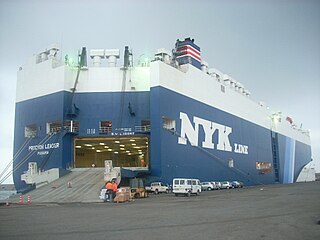
Roll-on/roll-off ships are cargo ships designed to carry wheeled cargo, such as cars, motorcycles, trucks, semi-trailer trucks, buses, trailers, and railroad cars, that are driven on and off the ship on their own wheels or using a platform vehicle, such as a self-propelled modular transporter. This is in contrast to lift-on/lift-off (LoLo) vessels, which use a crane to load and unload cargo.

LeShuttle is a railway shuttle service between Calais in France and Folkestone in United Kingdom. It conveys road vehicles and passengers by rail through the Channel Tunnel. Freight vehicles are carried in separate shuttle trains hauled by the same locomotives, that also contain a passenger carriage, known as the Club Car.

Konkan Railway Corporation Limited (KRCL) is an Indian public sector undertaking which operates Konkan Railway and also undertakes other railway-related projects. It is wholly-owned by the Government of India under the administrative control of the Ministry of Railways and headquartered at CBD Belapur in Navi Mumbai. The railway (railroad) route of KRCL covers the coastal districts of Maharashtra, Goa and Karnataka states of India.

Rail freight transport is the use of railroads and trains to transport cargo as opposed to human passengers.
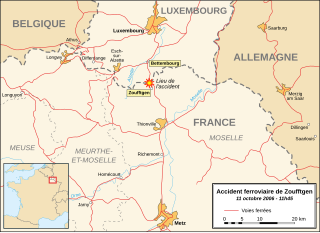
The 2006 Zoufftgen train collision occurred around 11.45 am on 11 October 2006, near Zoufftgen, Moselle, France, some 20 metres from the border with Luxembourg, on the Metz–Luxembourg railway line. Two trains collided head-on while one track of a double track line was out of service for maintenance. Six people, including the drivers of both trains, were killed: two Luxembourgers and four French. Twenty more were injured in the accident, two seriously.
Lorry-Rail is a rolling highway operator. Its mission consists of developing, promoting and marketing the new 1050 km rail-road service from Bettembourg, Luxembourg to le Boulou near Perpignan, France, for standard unaccompanied semi-trailers. It uses Modalohr piggyback wagons.

Open wagons form a large group of railway goods wagons designed primarily for the transportation of bulk goods that are not moisture-retentive and can usually be tipped, dumped or shovelled. The International Union of Railways (UIC) distinguishes between ordinary wagons and special wagons (F/6). Open wagons often form a significant part of a railway company's goods wagon fleet; for example, forming just under 40% of the Deutsche Bahn's total goods wagon stock in Germany.

Trailer on flatcar, also known as TOFC or piggyback, is the practice of carrying semi-trailers on railroad flatcars. TOFC allows for shippers to move truckloads long distances more cheaply than can be done by having each trailer towed by a truck, since one train can carry more than 100 trailers at once. The trailers will be moved by truck from their origin to an intermodal facility, where they will then be loaded onto a train, typically by a rubber tired gantry crane, for the bulk of their journey. Alternatively, trailers may be driven onto the flatcars via ramps by a terminal tractor. Near the destination, the trailers are unloaded at another facility and brought to their final destination by a tractor unit.

Flat wagons, as classified by the International Union of Railways (UIC), are railway goods wagons that have a flat, usually full-length, deck and little or no superstructure. By contrast, open wagons have high side and end walls and covered goods wagons have a fixed roof and sides. Flat wagons are often designed for the transportation of goods that are not weather-sensitive. Some flat wagons are able to be covered completely by tarpaulins or hoods and are therefore suitable for the transport of weather-sensitive goods. Unlike a "goods wagon with opening roof", the loading area of a flat is entirely open and accessible once the cover is removed.
Europorte Channel is a rail freight train operator which operates rail freight services between France and the United Kingdom through the Channel Tunnel. It is a subsidiary of Europorte.
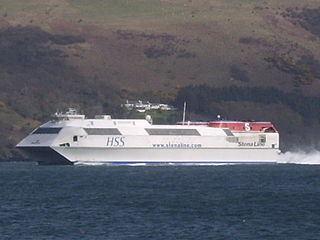
Accompanied combined transport is a form of intermodal transport, which is the movement of goods in one and the same loading unit or road vehicle, using successively two or more modes of transport without handling the goods themselves in changing modes. More specifically, accompanied combined transport is one of the two types of combined transport, which is intermodal transport where the major part of the journey is by rail, inland waterways or sea, and any initial and/or final legs carried out by road are as short as possible.

A car shuttle train, or (sometimes) car-carrying train, is a shuttle train used to transport accompanied cars (automobiles), and usually also bicycles and other types of road vehicles, for a relatively short distance.

Cargobeamer is an intermodal transport system. It involves specially designed pallets which can be carried on a road trailer; the pallets are fitted on top of flatcars but can slide sideways to allow trucks to drive on and off smoothly at intermodal terminals. A first testing terminal was opened in Leipzig in Germany; trial runs between Leipzig and Lithuania were planned in November 2010. Since July 2021, the first full CargoBeamer terminal is available to the public transport market in Calais, France.
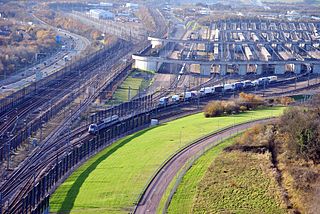
The Eurotunnel Folkestone Terminal is a railway terminal built for the transport of road-going vehicles on specially constructed trains through the Channel Tunnel. The station is located in Cheriton, a northern suburb of the town of Folkestone in the county of Kent. It is the terminal for the United Kingdom. On the French side is the Eurotunnel Calais Terminal located at Coquelles, near Calais. The passenger service building at the Eurotunnel Folkestone Terminal is called the Victor Hugo Terminal, named for the British author Victor Hugo.

The Lohr Railway System or Modalohr System uses special railway wagons of a type known as piggyback wagons, to carry standard road semi-trailers on the European rail network. They are currently used on the AFF route from France to Italy and Luxembourg to the French border with Spain and vice versa. There are plans to expand this service. They have also been approved for the Channel Tunnel. This articulated railway wagon consists of two low-floor decks, resting on a single Y25 jacobs bogie in the middle and on two Y33 bogies on the extreme ends. Using standard bogies resulted in lower maintenance costs compared with the similar rolling highway concept. The deck between the bogies (trucks) pivots (swings) 30°, allowing the trailers to be loaded from the sides. The cars are built by Lohr Industrie.
The Alpine rolling highway is a combined transport service, in the form of a rolling highway on special wagons traveling a distance of 175 km between France and Italy by the Mont Cenis Tunnel.

The kangourou wagon is a type of rail wagon designed for the transport of semi-trailers. It has a drawbridge forming a pocket in the low position allowing the carrier train of the semi-trailer to be placed and thus to respect the height of the loading gauge.
